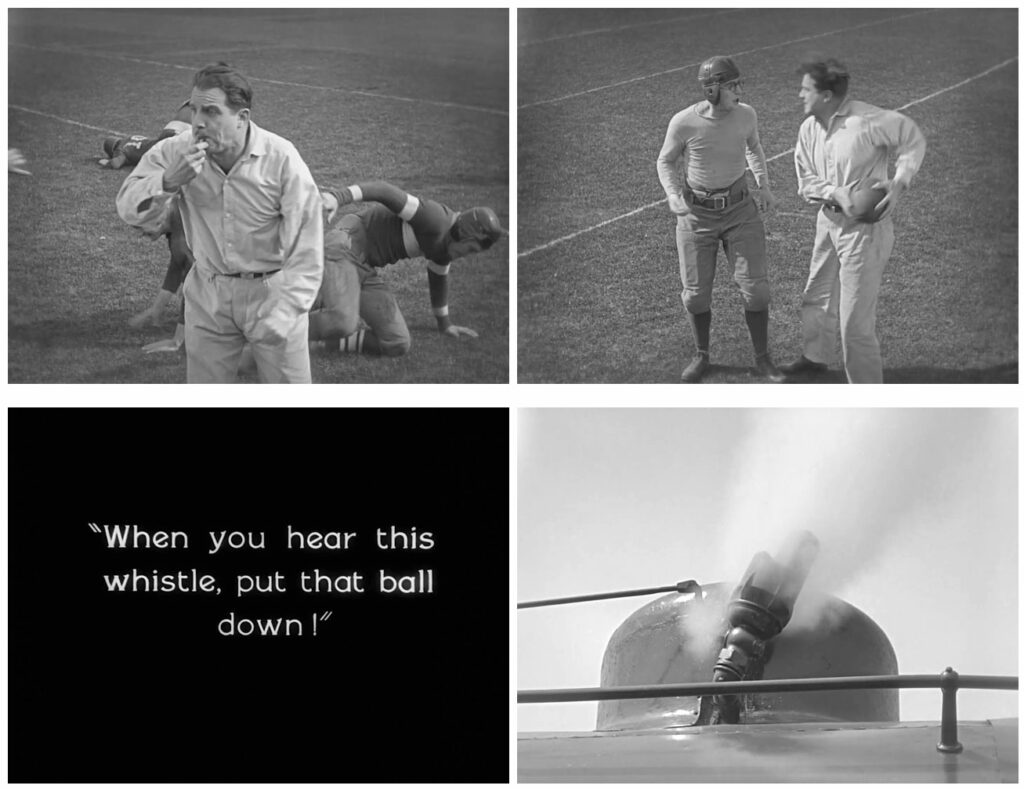I make mistakes during shows, and usually I’m the only one who notices. As an artist, often that’s all I come away with from a performance. On Tuesday I used the “toy counter” on the virtual Wurlitzer I often accompany silents with in a few spots, and one use undercut one of the gags, I’m afraid.
Sorry about that, Harold.
The Freshman (1925) has a lot of sound-related gags. The party scene has the running gag of ringing a small bell, there’s a moment when Harold hears a branch snap and thinks he back has, too, and there’s a gag with a whistle during the big football game.
Most theatre organs have a row of buttons that trigger sound effects, known as a “toy counter”. Horses hooves clippety-clop, doorbell, police whistle, boat whistle, fire alarm bell, chinese gong, etc. All the bells and whistles. Literally.
I like to use the sound effects on a theatre organ very sparingly, hardly at all actually. The double-edged sword for me is that part of me wants to let people know this was a facet of the unit orchestra, as these instruments were commonly referred to. The other part, the one that usually wins, is that the sound effects can call attention to themselves. No one’s expecting to hear them, so they can come out of nowhere for a novice audience.
But there are moments when there is a close-up of a bell-box ringing when a doorbell button is pressed or when a telephone call comes in where I often figure, during a show, well…if the film language is showing us a sound and I can also make that sound, then — as long as I can nail the synch — why not?
I don’t do sound effects when I’m on a piano. If a phone or doorbell rings, I will instead play something that musically supports the interruption in action or import of that character’s arrival at the door or by phone.
But sometimes, with a comedy, on the theatre organ, while a film is running I will remember I have this possibility. I opted not to match the branch snapping with a drum hit, and there are so many bell rings in that party sequence you really need to a third arm to nail all of them. So I didn’t. I did try using the bell-box sound for the moments when Harold sticks his sword in the footlight’s light socket and gets a shock. Because it supports the joke.
During the big football game, when (spoiler alert) Harold is finally and reluctantly put in, he does not heed the coach’s whistle. The coach pulls Harold aside and pointedly explains that he is to stop when he hears the whistle. During the next play, Harold is out on the gridiron with the rest of the team and, during a big play, we cut to a shot of an ocean liner’s whistle blowing. Harold gets over that he hears it, then stops and puts the ball down.

There is a boat whistle on most Wurlitzers, and there’s one on the Paramount Organ Works’ sample set that I use. It occurred to me to use it, and I did…matching the synch just fine. About a second later, I realized my mistake.
That wasn’t the joke. The joke is a pun, a text-audio pun — a unique sort that can only exist in the unique universe of Silent Film — a play on words/sounds on the word “whistle”. It still got a laugh, but the joke is that what the coach and the boat were both blowing are whistles, and not that Harold has mistaken one sound for another. He’d have to be a complete moron to do that, and I think even a complete moron knows the difference between a coach’s whistle and the giant, deep FOOP of a huge boat.
The joke is not acoustically literal, and is one that we accept in our right-brain. Whistle, whistle. We are supposed to make the mistake that Harold does, and hearing the wrong whistle sound does not support the joke.
Live and learn. I gave it a shot, and will consider the inherent joke of a visually-cued sound gag when deploying one of the toy counter samples again.